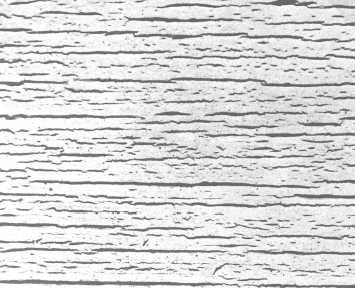without penetrating to the substrate. The pattern is
usually similar to that of a crow’s foot. Cracking is larger
with longer breaks extending through to the substrate
(fig. 8-10). Both result from stresses exceeding the
strength of the coating. But, whereas checking arises
from stress within the paint film, cracking is caused by
stresses between the film and the substrate.
Cracking generally takes place to a greater extent
on wood, due to its grain, than on other substrates. The
stress in the coating is greatest across the grain, causing
cracks to form parallel to the grain of the wood.
Checking and cracking are aggravated by excessively
thick coatings that have reduced elasticity. Temperature
variations, humidity, and rainfall are also concerns for
checking or cracking.
WOOD PRESERVATIVES
LEARNING OBJECTIVE: Upon completing
this section, you should be able to describe how
to treat wood for protection against dry rot,
termites, and decay.
There are three destructive forces against which
most wood protective measures are directed: biological
deterioration (wood is attacked by a number of
organisms), fire, and physical damage. In this section,
we’ll deal with protecting wood products against
biological deterioration.
Damage to wood buildings and other structures by
termites, wood bores, and fungi is a needless waste. The
ability of wood to resist such damage can be greatly
Figure 8-10.-Severe cracking.
increased
by
proper
treatment
and
continued
maintenance. Wood defects are also caused by improper
care after preservation treatment. All surfaces of treated
wood that are cut or drilled to expose the untreated
interior must be treated with a wood preservative.
APPLICATION METHODS
There are two basic methods for treating wood:
pressure and nonpressure. Pressure treatment is
superior to nonpressure, but costly and time consuming.
Building specifications dictate which method to use.
Pressure
The capacity of any wood to resist dry rot, termites,
and decay can be greatly increased by impregnating the
wood with a general-purpose wood preservative or
fungicide. It’s important to remember that good
pressure treatment adds to the service life of wood in
contact with damp ground. It does not, however,
guarantee the wood will remain serviceable throughout
the life of the building it supports.
Woods of different timber species do not treat with
equal ease. Different woods have different capacities for
absorbing preservatives or other liquids. In any given
wood, sapwood is more absorbent than heartwood.
Hardwoods are, in general, less absorbent than
softwoods. Naturally, the extent to which a preservative
protects increases directly with the depth it penetrates
below the surface of the wood. As we just mentioned, the
best penetration is obtained by a pressure method. Table
8-4 shows the ease of preservative penetration into
various woods. In the table, use E for easy, M for
moderate, and D for difficult.
Nonpressure
Nonpressure methods of applying preservatives to a
surface include dipping, brushing, and spraying. Figure
8-11 shows how you can improvise long tanks for the
dipping method. Absorption is rapid at first, then much
slower. A rule of thumb holds that in 3 minutes wood
absorbs half the total amount of preservative it will
absorb in 2 hours. However, the extent of the
penetration depends upon the type of wood, its moisture
content, and the length of time it remains immersed.
Surface application by brush or spray is the least
satisfactory method of treating wood from the
8-14

